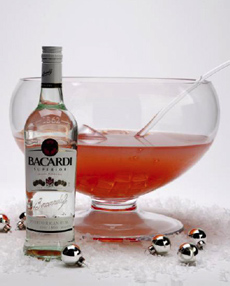TIP OF THE DAY: Go A-Wassailing
 Christmas punch bowl. Photo courtesy Baccardi. |
If you live in a community where you can walk from home to home, how about going a-wassailing? No one has to sing—that’s caroling. But you certainly can combine the two. Line up friends to participate, have everyone make a different punch (or egg nog). Start at one house, work your way down the line and then, if you like, vote on the best. Make it an annual tradition. “Wassail” began as a greeting among Anglo-Saxons, early Englishmen. Pronounced WASS-ul from the Middle English wæs hæil, it means “good health.” Centuries later, the term evolved into a drinking toast. The wassail bowl tradition began in the 14th century in southern England, home to apple groves galore and a lot of apple cider. The first wassail bowls contained hot mulled cider. When you come across references to “a cup of good cheer,” that’s what you were served. |
|
|
How does wassail fit in to these hot mulled drinks? During the holiday season in Merrie Olde [medieval] England, a host would invite friends over for a celebratory drink. The festivities began when the host held up the big bowl* of drink and exclaimed, “Wassail!” As wine became more plentiful—and there was a need to salvage bad batches of wine—hot mulled wine became an alternative to mulled cider. Both are still traditional Christmas drinks in Europe. Mulled wine is called Gløg in Sweden, Glögi in Finland and Glühwein in Germany. You don’t have to serve mulled cider or wine in your wassail bowl. There are many, many Christmas punch recipes, made with your favorite spirit or alcohol-free. |
||
|
WHAT DOES “MULLED” MEAN?
If you consult a dictionary, you’d think that mulled wine is one that is studied or pondered. According to Harvard University, the origin of the word “mull” to mean heated and spiced is shrouded in mystery. Mulling spices are a blend of allspice, cinnamon, cloves and nutmeg (what some Americans call “pumpkin pie spices”). The recipe varies, and star anise, cardamom and peppercorns can also be included, along with dried fruit such as apples, orange rind and raisins. Thus, a “mulled” drink is one which has been prepared with these spices. The technique is to heat the drink with the spices and then strain them out before serving. Mulling spices may also be added to the brewing process to make spiced beer. In the 17th century, merchant travelers of the British East India Company discovered the festive Indian drink, punch. The word “punch” is an English variation of the Hindi word, “panch.” Panch was made from five different ingredients: sugar, lemon, water, tea or spices and an alcoholic spirit. The word for “five” in Sanskrit is panchan–hence the name. |
 Mulled cider, with an optional splash of vodka. Photo courtesy Svedka Vodka. |
|
|
The concept was brought back to Europe, where it became a mainstream drink at festive occasions. After carbonated water (soda water) became available in the late 18th century, it became a sixth ingredient, added to the punch for some effervescence. However, the word for six in Sanskrit is shata. “Shat” just doesn’t work, so we’ll stick with “punch.” This non-alcoholic version of a wassail recipe combines apple cider and pineapple juice: certain to be popular with the kids. Start planning to go a-wassailing! |
||


